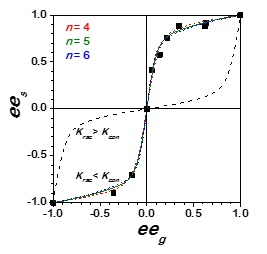Enantiomer Self-assembly on Single Crystal Surfaces
Yongju Yun, Soham Dutta
Crystallization of chiral molecules into racemate (rac) or conglomerate (con) structures or phases has been widely studied in three dimensions but very little is known about this behavior in two dimensions. In 3D, it is known that most chiral molecules prefer to crystallize into the racemate phase while only ~10% form conglomerates. The formation of rac and con phases on surfaces has important implications for enantiomer purification by adsorption, catalysis and crystallization. We are focused on quantifying tendency of rac vs. con formation in amino acid monolayers adsorbed on single crystal surfaces. Temperature programmed reaction spectroscopy, aided by isotopic labelling of functional groups, is used to probe the non-linear relationship between enantiomeric excess of gas phase (eeg) and adsorbed (ees) mixtures of amino acids in equilibrium with one another (Figure 1). The equilibrium constants for homo-(rac) or hetero-chiral (con) cluster formation are determined from amino acid adsorption isotherms. X-ray photoemission spectroscopy and Fourier transform infrared spectroscopy will be used to identify the nature of amino acid bonding to the surfaces and to corroborate the results of TPRS measurements. Surface explosion reactions of aspartic acid and other amino acids [1,2] have been studied in our group on chiral and achiral surfaces. Notably, on Cu(3,1,17), diastereomeric enantiospecific adsorption has been demonstrated [3]. Our group has also reported the first observation of chiral auto-amplification on an achiral metal surface, Asp/Cu(111)[4] and tendency of this system to self-assemble in a conglomerate phase.

Related Publications
- Y. Yun, A.J. Gellman, "Enantiospecific adsorption of amino acids on naturally chiral Cu{3,1,17}R&S surfaces" Langmuir; 2015, 31, 6055-6063 . View paper
- Y. Yun, D. Wei, D.S. Sholl, A.J. Gellman, "Equilibrium adsoprtion of D- and L-alanine mixtures on naturally chiral Cu{3,1,17}R&S surfaces" Journal of Physical Chemistry C; 2014, 118, 14957-14966. View paper
- Y. Yun, A.J. Gellman, "Enantioselective separation of DL-aspartic acid on naturally chiral Cu(3,1,17)R&S surfaces" Angewandte Chemie International Edition; 2013, 52, 3394-3397. View paper
- A.J. Gellman, Yongju Yun, "Adsorption induced auto-amplification of enantiomeric excess on an achiral surface" Nature - Chemistry; 2015 View paper